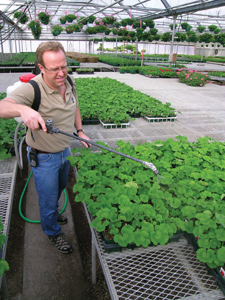8/15/2008
Spraying, Sprenching and
Drenching Your Plugs and Cuttings
Kurt Becker

It’s not hard to see that the application of pesticides to plugs and cuttings can be tricky compared with mature plants. The size and delicacy of these plants make applications physically different. The chemicals used can be different, as their stage of maturity attracts different problems. Additionally, there are more media sprays or “sprenches” than for mature plants, requiring a different type of coverage than general spraying. Finally, unique variety and concentration of types of plants at early stages may require different spray techniques, as only certain varieties may be targeted for a certain application.
Technique. Because plugs and cuttings are smaller and more fragile than plants at later stages of growth, different techniques are required. This is both to ensure good coverage and to protect the plant from mechanical damage. One important change is the force of the spray. With larger plants, the more dense the foliage, the more force that’s required for good coverage of all plant surfaces. With immature plants, you need less force. Sometimes this means reducing the pressure of your sprayer. Other times, it may simply require using a smaller nozzle tip to keep the droplets fine for good coverage with less momentum. Both of these changes can prevent forceful sprays that could damage delicate seedlings or dislodge freshly stuck cuttings. Sometimes, using different equipment is warranted. Using low-volume equipment can provide excellent coverage to plugs and cuttings with insecticides and fungicide, but without forceful application to the plants.
Chemicals. Different chemicals are often necessary because of the different needs of less-mature plants. Young plants can be plagued by different diseases and insects than mature plants. The chemical choice or the targeted area of the plant may require the use of different application techniques. Media sprays are often an effective way to apply both pesticides and plant growth regulators to an immature crop. Applications for fungus gnat control and plant growth control are often applied as a wet spray to the media. Different from a drench, a “sprench” (an application that’s between a spray and a drench in volume) is meant to wet the top layer of soil. This requires a different technique and, often, different equipment for best results.
Equipment. Finally, different equipment is better suited to spraying plugs and cuttings. Equipment can often be downsized simply because the area to be treated is typically much smaller that of mature plants. You might spray your finished crop with your trusty 100-gallon sprayer, but you’ll need much less volume when you apply a fungicide to your plugs. Many greenhouse operations keep smaller equipment with smaller tanks for just such applications. Backpack sprayers and 20-gallon equipment are a better fit for a 5- or 10-gallon application than a big tank sprayer. Also, many machines and spray guns are made for distance and broadcast applications. Spraying plugs and cuttings often requires a much more targeted approach. When spraying only 10 trays of impatiens plugs, a gun designed to throw an 8-inch wide pattern at 15 feet will cover much more than you need.
By considering the types and sizes of plants you are growing and the types of applications you need to make to those plants, you can maximize your efficacy and minimize your waste and damage.
Kurt Becker is Director Commercial Sales and Marketing at Dramm Corporation, Manitowoc, Wisconsin. Tel: (920) 684-0227.